

Birding Map of Kruger Park Central Grasslands
Satara Area
The drives around Satara Camp are probably the best place in Kruger to see the big grassland birds, those imposing enough to muscle their way into the best turf. These are the Common Ostrich*, Secretarybird, Kori Bustard and the Black-bellied Bustard* (which is not found much further north than the central grasslands).
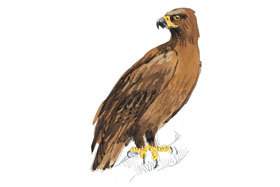 The fact that the landscape accommodates all these big birds indicates how much nutrition there is in the central grasslands. This is why the Satara area is good for game spotting in general.
The fact that the landscape accommodates all these big birds indicates how much nutrition there is in the central grasslands. This is why the Satara area is good for game spotting in general.
It is a grazers' heaven, and in the wake of the zebra, buffalo, impala, wildebeest and other grass-eaters, birds like the Sabota Lark, African Pipit* and Chestnut-backed Sparrowlark* follow. These species are most visible in summer in areas where the veld has been over-grazed.
Vulture sightings are a feature of the central grasslands. The most commonly seen is the White-backed Vulture. Invariably, several species gather at a kill, the other usual suspects being the Lappet-faced, White-headed and Hooded Vultures and less frequently, the Cape Vulture.
The grasslands are sublime after heavy rains. The underlying basalt holds the water well and numerous vleis and pans emerge along the drainage lines in the veld. These draw lots of birds, particularly insect eaters. The Magpie*, Red-backed and Lesser Grey Shrikes are some of the more aggressive hunters in the Knob-thorn and Marula savanna.
Game birds to look out for are the Common Quail, Harlequin Quail and Kurrichane Buttonquail. Interestingly consulting editor Ian Whyte has questioned whether the Common Quail is found in Kruger at all. The male of the species is very similar in appearance to the female Harlequin Quail, and he believes the two may often be confused.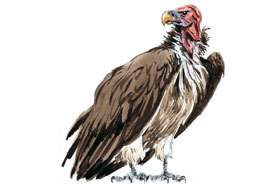
The movements of quails through Kruger aren't yet well understood, but they appear to breed in the Park during summer and spend their winters further north in Africa. Their appearance in different parts of Kruger is quite sporadic and seems to be linked to rain cycles. Some say the whit whit whit call of the Harlequin Quail sounds like 'wet my lips, wet my lips'.
Other grassland birds here are the Monotonous and Flappet Larks, Desert Cisticola* and the Southern Black Tit. The Southern Black Tit has a close association with combretum (bushwillow) trees.
In autumn, it may be seen feeding on bushwillow pods - it holds the pod down with its foot and pecks a hole in it to get at the wasp larvae inside. There is usually a profusion of Lilac-breasted and Purple Rollers in this environment.
Girivana Dam (5km along the S12 off the H7) is one the best places for seeing lions in Kruger. The best time to visit is dawn when they are most likely to be drinking. The water hole is good for early morning photography. There are usually lots of hornbills around Girivana.
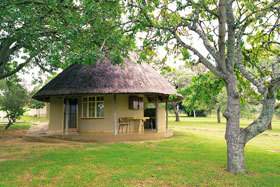 SATARA CAMP
SATARA CAMP
Satara is a large camp in the middle of Kruger. Set in the flat, prime game-viewing Knob-thorn and Marula savanna plains, Satara is the second largest camp in the Park. Its name is derived from the Hindi word satra , which means seventeen . It was designated farm number 17 by the Indian surveyor who originally plotted the farms before they were donated by Eileen Orpen to the Kruger Park.
Satara probably offers the best chances of seeing lion and the birding isn't bad either. Unlike most other camps, it is not situated on a major river, although it is close to the confluence of the Shitsakana and N'wanetsi watercourses, which have well-developed, riverine woodlands.
In the camp itself, some of the specialities include Black Crake, which sometimes can be seen in the pond in the middle of the camp. Raptors are often seen and it is not uncommon to see a swirling circle of vultures high above.
Blue Waxbills are a common winter feature of Satara with over 100 birds nesting in the acacia canopies, often taking over old weaver nests. Blue Waxbills are known for their greeting displays after periods of separation - they raise their tails, bow, and wipe beaks with birds they haven't seen for a while.
They are very comfortable around human habitation. They appear to have an interesting relationship with wasps, often nesting near wasp colonies in order to deter predators from coming too close.
Satara is also a mecca for Red-eyed and African Mourning Doves, while there is lots of weaver activity with the Red-billed Buffalo-Weaver, Thick-billed Weaver and Lesser Masked-Weavers in residence.
Other Satara birds include Burchell's Starling, Bennett's Woodpecker, Thick-billed Cuckoo and Groundscraper Thrush. The Groundscraper Thrush is a sociable bird even though it is often solitary. It is especially attracted to areas where there has been fire, and will forage on the ground, seizing insects and slugs.
African Hoopoes nest in holes in the ground in the camp. During summer, the Woodland Kingfisher is extremely vocal.
Stay at Satara Rest Camp
Sweni River Road (S126)
A recommended drive south of Satara is the Sweni River loop (S126), accessed off the main Tshokwane Road (H1-3). The N'wanetsi River crossing on this road is a good birding stop with a dam to the west of the bridge. Look out for Brown-headed Parrots in the tall woodland trees, which stand in stark contrast to the stunted Knob-thorn savanna that stretches to the east.
The Sweni River Road is a surprisingly tropical landscape given that it is so far south of the Tropic of Capricorn. Many old Kruger hands insist that it is the Sweni that marks the start of the north rather than the Olifants River. Southern Lala-palms and combretums dominate the grassy floodplains between the river and the road, giving the bush a distinctly Zimbabwean feel, with lots of swallows and starlings.
In summer, this is often a good road for White Stork, and the Namaqua Dove. The African Cuckoo's call can usually be heard from mid-September, heralding this shy and secretive bird's arrival from further north in Africa. There are sporadic records of the Long-crested Eagle along the Sweni River road.
Where to stay in Central Grasslands

Heavy Feathers
Shangaan elders will caution a young man not to be like a bustard and urge him to make sure he leaves a clean track record behind him when he moves on in life. This appears to be in reference to the fact that the Kori Bustard - which usually flies only when it's in danger or alarmed - often excretes before it takes off. Male birds weigh an average of 12.5kg, making it the world's heaviest bird capable of flight.
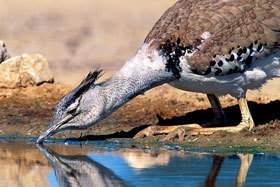 They have big wings, measuring up to 2.5m from tip to tip - but yet don't fly often. Researchers in Kruger say that the Kori Bustard spends only 3% of its time in the air.
They have big wings, measuring up to 2.5m from tip to tip - but yet don't fly often. Researchers in Kruger say that the Kori Bustard spends only 3% of its time in the air.
In 237 recorded observations, it was found that most time (69%) was spent walking around the veld looking for prey, 5% spent actually eating, 3% drinking, 1% communicating with other birds, and 19% of its time doing nothing at all.
There are between 100 and 250 Kori Bustards in Kruger, found singly or in small groups in open to lightly-wooded grassland. They are polygamous birds with no pattern of pair bonding. The Kori Bustard can eat almost anything. It has a broad diet, feeding on grasses, seeds, roots and berries as well as insects, lizards, small snakes, chameleons, rodents, carrion and the eggs and nestlings of other birds.
Roberts VII reports on the rather unusual stomach contents of two birds that were dissected soon after they had died - one bird had swallowed a piece of bone, a 12-bore shotgun shell, 2 bullet shells and a four-centrimetre square piece of flat metal, while the other bird had 60g of broken glass and a plastic tail-light in its stomach.
The Kori is known for its remarkable courtship displays - it struts around with its crest erect, puffs out its throat feathers to make its neck appear four times larger than it is, lowers its tail and then emits a booming noise.Despite all the show, copulation is brief, taking only a few seconds.
The Kori Bustard lays its eggs in a shallow scrape in the ground. Eggs are vulnerable to foraging by leopards, jackals, baboons and warthogs. Adult birds are a delicacy for lions, cheetahs, leopards, jackals and pythons.
The Martial Eagle is probably the Kori Bustard's most dangerous avian enemy. Kori Bustards are not shy to show their own aggression - some birds have been seen making threat displays towards zebras at a water hole.
SINGITA LEBOMBO
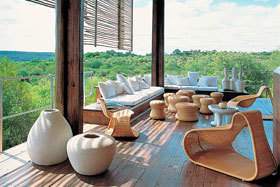 Singita Lebombo concession is Kruger's most upmarket experience and an intriguing birding location. The camp sits discretely within the Lebombo koppies overlooking the N'wanetsi River. It is unashamedly contemporary with its Zen-meets-Africa décor, a blend of natural stone, chrome and glass and a cocktail verandah that has stunning views over the surrounding rocky hills.
Singita Lebombo concession is Kruger's most upmarket experience and an intriguing birding location. The camp sits discretely within the Lebombo koppies overlooking the N'wanetsi River. It is unashamedly contemporary with its Zen-meets-Africa décor, a blend of natural stone, chrome and glass and a cocktail verandah that has stunning views over the surrounding rocky hills.
Each unit is set along the river with its own private deck. One of Singita Lebombo's features is the way the landscape has been incorporated into the lodge design - this works particularly well at the outside eating area, where a stand of huge euphorbia trees are dramatically lit up at night.
There is good birding in the 15 000ha Singita Lebombo concession because of the variety of habitats, including the Lebombo mountains with their rocky outcrops and lush riverine gorges, the central grasslands and mixed woodlands.
The N'wanetsi and Sweni Rivers join in the concession and there are a number of vleis along the Lebombo foothills that turn into marshes during the rainy season. These factors ensure that there is a high concentration of game in the concession, and a diversity of birds. Indeed, camp rangers believe 470 species of birds have been seen in the area out of Kruger's total of 500 or so known species to reside in or visit the Park.
Among the birds of the central Lebombo are Kruger's regular raptors - the Bateleur, Yellow-billed Kite, Steppe Eagle and Black-chested Snake-Eagle which nests in the euphorbia trees on the mountain slopes. Commonly seen birds include the Cinnamon-breasted Bunting*, African Stonechat* and the Grey Tit-Flycatcher*, while a Kruger rarity, the nomadic Lesser Jacana, is sometimes seen along the N'wanetsi watercourse.
Some of the more unusual sightings include the Ovambo Sparrowhawk and the Bokmakierie, which are usually associated with the drier western half of South Africa, and the Madagascar Cuckoo, which is one of the 12 species of cuckoo recorded in the central Lebombo.
Coastal birds like the Grey-headed Gull are also spotted on occasion, either following the rains for food or being blown off course by storms in Mozambique.
There are two camps in the Singita Lebombo Concession. The main one is Singita Lebombo itself, where the 15 luxury units have glass walls and their own private viewing decks. Singita Lebombo's entertainment area has stunning vistas over the river and surrounding koppies, and in the words of one reviewer, is 'overwhelming in terms of scale and silence'.
The other camp is Singita Sweni, a more intimate camp with six luxury units, set in the rocky woodlands overlooking the Sweni River.
Guests at both camps have access to the Lebombo Village, which includes a health spa, gym, craft and homewares shop, art gallery and impressive wine cellar.
Stay at Singita Lebombo
Stay at Singita Sweni
Satara to Nwanetsi (H6 and S100)
The roads east of Satara - the tarred H6 and the S100 dust road just north of it - are grassland birding drives. The H6 is 'Starling Boulevard' because of the number of these birds in the stunted thorn savanna. Black-shouldered Kites are not often seen in Kruger but are periodically dominant along this road, which has two main water holes - Shishangani and Sonop.
Birding here is a matter of timing and luck. Your authors have not witnessed much here to write home about, but editor Ian Fleming once saw a Martial Eagle attack a Kori Bustard at Sonop Water Hole.
The better road from Satara eastwards is the S100, which closely follows the N'wanetsi River as it twists and turns through the flat plains before it joins the old main road just south of Gudzani Water Hole.
In summer, there are lots of Southern Carmine Bee-eaters along this road and there are regular sightings of the African Pipit. There are several inspiring stopping points in the riverine bush along this road.
As one moves eastward on either the H6 or S100, the bigger woodland trees are restricted to watercourses and the Knob-thorn and combretum bush become increasingly stunted as a consequence of the drier climate.
N'wanetsi and Sweni
N'wanetsi Picnic Site is downstream from Singita Lebombo on the N'wanetsi River. There is no shop or restaurant at the site but cold drinks and firewood are available. Kruger staff report that a regular sighting here is the Yellow-bellied Greenbul*, which forages in the thicker undergrowth and emits a curious call that combines the timid yapping of a little dog with a scolding chuckle.
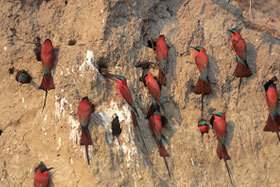 Other birds seen here are the Violet-eared Waxbill, the Mocking Cliff-Chat and on occasion, the Shaft-tailed Whydah.The Long-tailed Paradise-Whydah is known in Shangaan as Mtikahineila (Mtika - heavy, Neila - tail ) referring to its seemingly uncomfortable flight when its tail grows long in breeding season.
Other birds seen here are the Violet-eared Waxbill, the Mocking Cliff-Chat and on occasion, the Shaft-tailed Whydah.The Long-tailed Paradise-Whydah is known in Shangaan as Mtikahineila (Mtika - heavy, Neila - tail ) referring to its seemingly uncomfortable flight when its tail grows long in breeding season.
The Long-billed Crombec, on the other hand, is called Nqcumu , which means tailless.Sweni Water Hole, just south of N'wanetsi on the Trichardt Road (S37) has winter sightings that are as good as summer ones. That's because of the shape and structure of the water hole.
When water levels are low during the cold, dry season, rocks, mud banks and reeds are exposed giving better feeding for water birds and many passerines from the surrounding grasslands. In summer, however, particularly after heavy rains, the water hole fills up covering much of the food source and there is sufficient water and food elsewhere.
The birds usually seen at Sweni Hide include the Hamerkop, Green-backed Heron and Great and Little Egrets. Ian Whyte says this is the best place in Kruger to see small flocks of the Blue-cheeked Bee-eater. They breed from the Nile Delta to Pakistan and are summer visitors to the Mozambican coastal plains on the other side of the Lebombo.
Satara to Olifants (H1-4)
The road north of Satara bisects open grasslands where most of Kruger's grassland species are to be found. The Knob-thorn here is widely dispersed and the drainage lines are clear because they are marked by tall trees, especially Leadwoods, which thrive in this area.
This is a good drive to test one's ability to identify larks; look out for the Chestnut-backed Sparrowlark* and the Red-capped Lark. In dry years, Lark-like Buntings make their appearance in this part of Kruger.
Some Kruger birding experts believe this stretch of the Great North Road is the best place to see the rarely-seen Pallid and Montagu's Harriers in summer.
From Witpens Water Hole, tree size begins to diminish and shrubveld dominates. Knob-thorns dominate the landscape. The Magic Guarris of the south are gradually replaced by Grewia species, or raisin bushes as they are more commonly known. Look out for Little Bee-eaters in this vicinity.
At Witpens, you can take the Old Main road (S90), which leads into the eastern grasslands past Gudzani and Bangu Water Holes up to Balule. Birds to look out for along this stunted Knob-thorn route include the Long-tailed Paradise-Whydah, Senegal Lapwing*, Bronze-winged and Temminck's Coursers.
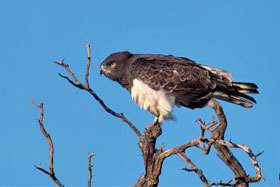 Small flocks of Black Heron* are sometimes seen where there is permanent water in the central grasslands. Black Herons* hunt by themselves - each bird walks through shallow water or on the shoreline, using its wings to create an umbrella-like canopy. This action has the effect of flushing small fish and insects into movement, which makes them easier targets.
Small flocks of Black Heron* are sometimes seen where there is permanent water in the central grasslands. Black Herons* hunt by themselves - each bird walks through shallow water or on the shoreline, using its wings to create an umbrella-like canopy. This action has the effect of flushing small fish and insects into movement, which makes them easier targets.
The central grasslands are the favoured habitat in Kruger for Red-billed Queleas, nomads whose appearance in Kruger appears to be sporadic and linked to years of higher rainfall. According to research by Kemp and Whyte these 20g birds move rapidly over long distances and can breed at short notice.
The signal for breeding is when the female's bill turns yellow. Males build nests within a day, and the incubation period is the shortest of any bird, taking only 10 days from laying to hatching.
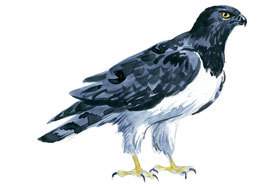 Alongside the H1-4 are a series of pans in the Ngotso River watercourse. Their source is Ngotso Vlei, the main water hole between Satara and Olifants. The African Fish-Eagle frequents this marshland, which is at its best after summer rains although it has been dammed to retain the water in winter.
Alongside the H1-4 are a series of pans in the Ngotso River watercourse. Their source is Ngotso Vlei, the main water hole between Satara and Olifants. The African Fish-Eagle frequents this marshland, which is at its best after summer rains although it has been dammed to retain the water in winter.
Nyamarhi Spring marks the start of the Olifants Rugged Veld, an angular landscape dominated by dark basalt stone, thorn thickets and woodland trees along the drainage lines.
One of the more common swallows to be seen, especially in the central grasslands, is the Barn Swallow, a summer visitor from Europe. It is found in large flocks in the more moist grasslands of southern East Africa. There is a huge annual migration of these birds - up to 100 million fly south from Eurasia every year between late October and March. Like all swallows, they are quick and graceful flyers - a Barn Swallow ringed in Gauteng was found on the eastern shores of the Black Sea in Georgia 34 days later.

